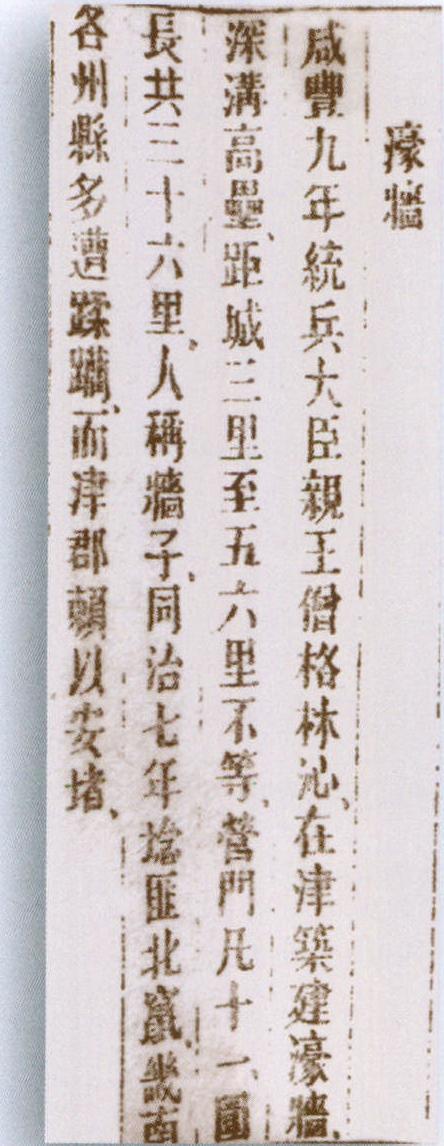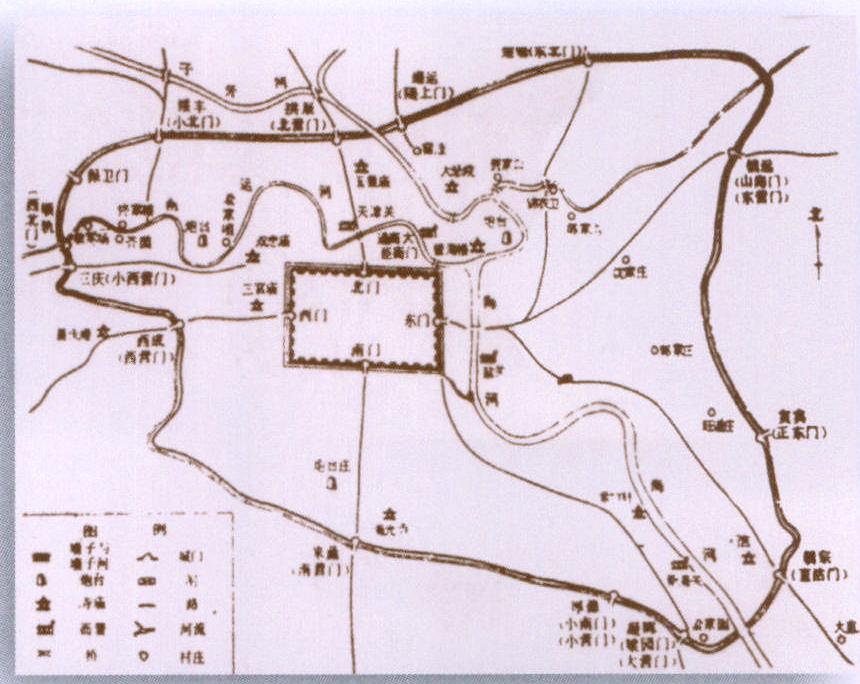历史百科 修筑壕墙
Posted 捻军
篇首语:我们一路走,一路被辜负,一路点燃希望,一路寻找答案。本文由小常识网(cha138.com)小编为大家整理,主要介绍了历史百科 修筑壕墙相关的知识,希望对你有一定的参考价值。
历史百科 修筑壕墙
修筑壕墙,是指近代以后,为了加强天津的城防,而修建墙子和墙子河。近代以前,天津的城防,主要是依靠天津城廓。清咸丰八年(1858)英、法联军第一次侵占天津,胁迫清政府签订《天津条约》以后,清政府决定加强天津的防御能力。僧格林沁到天津后,即上奏朝廷:“天津为紧要重地,亟应设法严防。揆之地势,亦应附城一带,挑挖重濠,筑立土城,将四门关厢,圈入重濠,设有警动,守濠即系守城,致为得力。” 咸丰九年 (1859)十二月,清廷批准僧格林沁挑濠筑墙。
咸丰十年 (1860)正月二十六日,修筑天津墙子和墙子河的工程??工。据同治年编纂的 《续天津县志》记载: “壕墙距城里余或五、六里不等,营门凡十一,东至沈家庄,东北锦衣卫桥、窑洼,北玉皇庙,西北佟家楼、教军场,西至善庆庵、三官庙,南海光寺,东南梁家园、行宫,围长共三十六里,濠如是。”近城河道及城外居民铺店密集地带,均圈入土墙之内。还设大炮台两座,小炮台数10座。
天津开埠以后,墙子已失去作用。但同治八年(1869),三口通商大臣崇厚,为了防御捻军进攻天津,又将壕墙重修。同年四月,壕墙阻堵了捻军的攻城。《续天津县志》有这样的记载: “匪(指捻军)聚于南乡八里台??带,叠次冲扑不能犯,郡城赖以安堵,亦始知濠墙足恃。”
到光绪七年(1881),李鸿章任直隶总督时,认为天津除了城墙之外,无险可守。便重新把墙子加固,濠挖深,重修各门,并题门名。共开14座营门(清朝军垒曰“营” ,驻扎军队的门称作“营门” ),门以砖石砌筑,两旁有高大的砖垛,门上有额,上刻营门名字。
例如: 东曰 “寅宾门” 、东北曰 “建魁门” 、东南曰 “朝宗门” 等。但是老百姓习惯按营门的方向来称呼。北边叫 “北营门” 、南边叫 “南营门” ,其它叫 “大营门” 、“小营门” 等。
清光绪二十三年(1897)绘制的墙子和墙子河示意图,突出了俗称,而官方所题门名,反而成为备注了。按图所示壕墙位置,是从河西区粱家园 (今海河中学)起,沿南京路经过“大营门” 、“小营门” 、“南营门” 、“西营门” 到 “三元村” ,越过南运河,沿邵公庄铁路基,经过 “北营门” ,仍沿铁路基过新??河,经过小树林街道口 ( “东营门” ) ,再沿铁路基到唐家口,经过旧俄租界( “直沽门” ) 、五十四中学,达海河右岸。(这个示意线路是1995年以前的情况)

·清代《津门杂记》对壕墙的记裁
With the aim to strengthen its defense,Tianjin dug a moatand built ramparts around the city in modem history. In thepast,the last resort of Tianjin\'s defense was its ramparts,which got frequent renovations in Ming and Qingdynasties. In 1858 (the 8th year of Emperor Xianfeng),theallied forces of UK and France invaded Tianjin for the firsttime and forced Qing Dynasty to sign the Tianjin Treaty.Qing Dynasty was scared by the invasion of the alliedforces and decided to reinforce the defense of Tianjin.When Prince Sengge Renchin came to Tianjin,he reportedto the court that "Tianjin is a strategic pass whose defenseshould be enhanced. Considering its topography,weshould dig moat and build ramparts. When the four citygates are closed,the city will be protected by the moat.To protect the city is to keep the moat safe." In December1859,the court approved Sengge Renchin\'s appeal andrequired to protect the businessmen at the outskirts of thecity.
In January 1860,the project of digging moat andbuilding ramparts began. According to the Sequel ofTianjin Annals,"The ramparts are about one to fivemiles away from the city. Its east end is Shenjia Village;northeast,Jinyiwei Bridge and Yaowa; north,YuhuangTemple; northwest,Tongjia Building and Jiaojun Square;west,Shanqing Nunnery,Sanguan Temple,and SouthHaiguang Temple; and southeast,Liangjia Garden andXanadu. The whole length of the moat is 18 kilometres,the same as to the ramparts." Rivers and channels nearthe city and shop malls were all enclosed by the ramparts.Two large fortifications and dozens of smaller ones werebuilt.
After the opening of Tianjin as a treaty port,the wallsof the city began to lose their function. In 1868 when theNian Rebels marched on to the north,Assistant MinisterChong Hou in charge of the three-seaport businessrenovated the ramparts thicker and stronger. In April,the Nian Rebels arrived at the gates of Tianjin but failedto enter into the city due to the ramparts. The Sequel ofTianjin Annals says that "the Nian Rebels accumulatednear Balitai of Nanxiang and they suffered failure forseveral times in attacking the city because of the hurdle ofthe ramparts".
In 1881 (the seventh year of Emperor Guangxu),Li Hongzhang was nominated as the Governor-Generalof Zhili. He believed that Tianjin had nothing to defenditself except for the walls and moat. Because both thecity and the population of people and army was growing,the concession was built beside the river,the sole way ofdefense was to depend on the walls and trenches,so hereinforced the walls and deepened the trenches. He alsorebuilt 14 gates for barracks and named them. The gateswere made from bricks and stones and on the top of themthe barracks\' names were engraved.
The names were elegant such as Yinbin Gate,JiankuiGate and Chaozong Gate according to their directionsin traditional Chinese,but the civilians were used to callthem "North Yingmen (barrack)","South Yingmen" or"Big Yingmen",and "Small Yingmen".
The 1897 map of Tianjin ramparts and moat adoptedthe common names and the official names becameremarks.

·壕墙示意图
相关参考
匈奴被驱逐后,如何建设永久性的国防保障,亦即秦始皇巩固边防的谋略,为北击匈奴的后续步骤。修筑长城,移民实边,二者为巩固边防谋略的主要内容,当然还包括修筑直道等配套工程。> 有关秦长城的工程布局,
许多人以为修筑长城是秦始皇开头的,其实,早在战国时期,这项浩大的工程即已开始。春秋战国时期,列国纷争,各诸侯国都于险要据点兴建单个的防御城堡及用于传递军情的烽火台等设施,随后逐渐在边境上修筑城墙,把这
万里长城是中国古代劳动人民智慧和力量的结晶,是人类建筑史上罕见的古代军事防御工程。 许多人以为修筑长城是秦始皇开头的,其实,早在战国时期,这项浩大的工程即已开始。春秋战国时期,列国纷
1936-1939年修筑齐格菲防线1936-1939年,法西斯德国在扩军备战的过程中,为了同法国的马其诺防线相抗衡,在西部边境修筑了一个庞大的防御阵地体系,即所谓的“齐格菲防线”。防线自亚琛至巴塞尔,
背景: 从北京到张家口的铁路长二百千米,是联结华北和西北的交通要道。当时,清政府刚提出修筑的计划,一些帝国主义国家就出来阻挠,他们都要争夺这条铁路的修筑权,想进一步控制我国的北部。帝国主义者
导读:长城,不仅是中华民族的骄傲,也是世界建筑史上的一大奇迹,作为世界七大奇迹之一无人不感叹它的浩大与伟岸,但是你否是直到秦始皇修筑长城的真实原因?如果说秦始皇修筑长城只因一句荒唐谎言,你信吗?作者张
如果说秦始皇修筑长城只因一句荒唐谎言,你信吗?作者张永廷和张馨文在《秦始皇为何要修万里长城》一文里,告诉我们这看似令人啼笑皆非的理由是真实的,皆因一句“亡秦者胡也”的谎言而修建。“亡秦者胡也”,万里长
揭秘秦始皇因一句谎言而修筑万里长城 长城是世界建筑史上的杰作,它盘踞在重峦叠嶂之间,蜿蜒在沙漠之上,气势磅礴,坚固雄伟,被视为世界七大奇迹之一。曾有权威人士做过统计,修筑长城所用的砖石,
1943年11月修筑卡西诺防线卡西诺是意大利拉齐奥东南山区小城镇。6世纪初叶由圣本尼迪克特建立的蒙特卡西诺修道院负责治理。1943年11月,德国法西斯陆军元帅凯塞林命令在卡西诺周围修筑大规模的防御工事
为什么说隋炀帝修筑运河有功也有过?隋朝末年,隋炀帝下令开凿了一条通往江南的运河—京杭大运河。修筑运河共用了大约6年时间,动用民工100多万,给百姓带来了沉重的负担和巨大的灾难。不过,京杭大运河开通以后